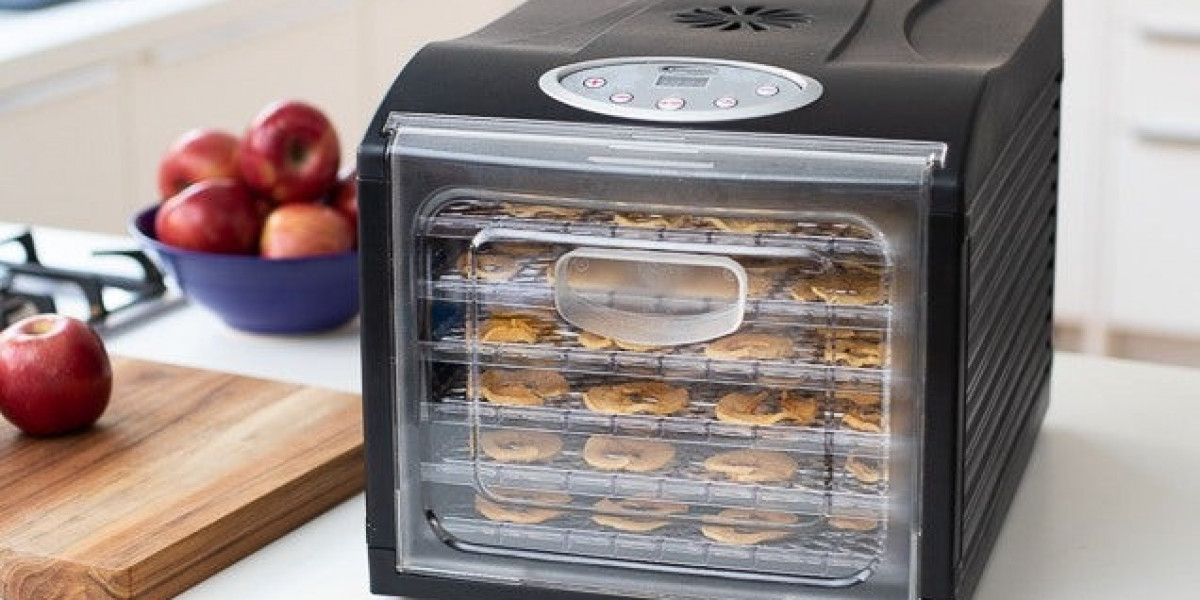The dehydrator machine is a practical appliance designed to preserve food by removing moisture, thereby inhibiting the growth of bacteria and mould. This method of preservation has been used for centuries, but modern machines have made the process more efficient and accessible. By using controlled heat and airflow, these devices dry various foods—fruits, vegetables, and meats—without the need for additives. As a result, they provide an alternative to traditional methods such as freezing or canning, which may alter the food's natural flavour or texture. With increasing interest in sustainable living and reducing food waste, the dehydrator machine has become a valuable tool in kitchens.
How Dehydrator Work?
A dehydrator operates by combining controlled heat and airflow to extract moisture from food, thereby preventing spoilage. This appliance typically features a heating element, a fan, and a series of trays for holding food. The heating element generates warm air, which the fan distributes across the trays, ensuring even exposure of all food surfaces.
The trays, often stackable or removable, allow for simultaneous drying of multiple items while maintaining airflow efficiency. Consistent temperature regulation is crucial to the process, as excessive heat can diminish the flavour and nutritional content of the food, while insufficient heat may fail to remove enough moisture.
Benefits of Using a Dehydrator
Using a dehydrator allows the creation of preservative-free snacks and ingredients, making it a healthier alternative to processed foods. This appliance can significantly reduce food waste by extending the shelf life of perishable items, offering an economical way to utilise surplus produce effectively.
Additionally, features such as a timer or an automatic shut-off function can enhance convenience by allowing more precise control over dehydration durations. Accessories, including additional trays or specialised mats for smaller items, can further expand the appliance's versatility, making it suitable for a wider range of uses.
Storage Or Consumption
Proper spacing of food on the trays facilitates optimal air circulation, further aiding dehydration. The combination of these components and mechanisms ensures that foods retain their taste, texture, and nutrients, transforming them into long-lasting, lightweight products suitable for storage or consumption.
Additionally, the lightweight nature of dehydrated foods makes them convenient for storage and transportation, particularly for outdoor activities or limited storage spaces. The ability to dry a variety of food items, such as fruits, vegetables, meats, and herbs, enhances meal planning and preparation, ensuring year-round access to seasonal ingredients.
Key Features to Consider: Best Dehydrator
When assessing a best dehydrator, certain features are crucial to its functionality and suitability. Adjustable temperature settings are particularly important because they allow precise control to accommodate different foods, ensuring optimal results. The appliance's capacity is another significant factor; machines with larger tray spaces or stackable trays are ideal for processing greater quantities in a single session.
Material quality and build are also worth noting, with durable components contributing to longevity and consistent performance. Noise levels should not be overlooked, especially if the machine will be used frequently or for extended periods. Energy efficiency is another practical consideration, as it can reduce long-term operating costs.
Types of Dehydrators
Dehydrators are primarily categorised into vertical-flow and horizontal-flow models, each offering distinct advantages. Vertical flow models feature the heating element and fan positioned either at the base or the top, resulting in air circulating vertically through the trays. These designs are typically compact and more affordable, making them suitable for smaller kitchens or limited usage.
However, they may sometimes dry food unevenly, particularly when trays are overcrowded or filled with items of varying moisture content. Horizontal flow dehydrators, on the other hand, place the fan and heating element at the back of the appliance.
Tips for Choosing the Dehydrator
Selecting the ideal dehydrator involves assessing key features that align with individual preferences and intended usage. Machines with adjustable temperature controls are advantageous for handling a range of foods, ensuring precise drying conditions. Models with ample tray capacity or stackable designs accommodate larger quantities, making them suitable for those preserving significant amounts of produce.
Durability is an important factor, with robust materials contributing to reliable, long-term performance. Noise levels may also influence the choice, especially for appliances intended for frequent use. Energy-efficient models help reduce operational costs over time, offering practicality and sustainability.
Additional features, such as timers or automatic shut-off functions, provide convenience by simplifying the drying process. Accessories like non-stick sheets or extra trays can expand the machine's versatility, enabling the dehydration of smaller or stickier items. Considering these elements ensures the appliance effectively meets the user's needs.
Common Mistakes to Avoid
Overpacking the trays is a common error that can obstruct airflow, leading to inconsistent drying and longer processing times. Similarly, uneven slicing may cause some pieces to dry more quickly than others, compromising overall quality. Skipping pre-treatment steps, such as blanching or dipping certain fruits and vegetables, might affect their colour, texture, or taste after dehydration.
Neglecting to rotate trays, especially in models without horizontal airflow, can lead to uneven drying, as the food closest to the heating element dries faster. Furthermore, failing to properly clean the appliance after use could lead to cross-contamination or lingering odours that may affect future batches. Attention to detail is essential for achieving consistent, high-quality results with a dehydrator.
Care and Maintenance
Proper care and maintenance of a dehydrator involves several key practices to ensure its efficiency and longevity. After each use, trays and removable parts should be cleaned thoroughly to prevent residue buildup, which could lead to unpleasant odours or contamination in future batches.
Non-stick sheets or liners, if included, require gentle cleaning to maintain their surface integrity. The appliance’s fan and vents must be inspected regularly to ensure unobstructed airflow, as dust or debris can impact performance. The exterior should also be wiped down with a damp cloth to maintain cleanliness and appearance.
Extreme Temperatures: Best Food Dehydrators
Checking the power cord and connections for any signs of damage is advisable, as worn components can compromise safety. If the machine includes filters, best food dehydrators may need to be replaced periodically according to the manufacturer’s recommendations. Storing the device in a clean, dry area away from extreme temperatures will further protect its components. Following these practices can promote reliable and consistent operation.
This arrangement promotes consistent air distribution across all trays, ensuring uniform drying for a wide variety of foods. These models are often preferred for handling larger quantities or diverse items, as they provide more precise results. The structural design of horizontal flow dehydrators also prevents flavours from mixing, an important feature when drying different types of food simultaneously.
Dehydrating Different Types of Foods
A dehydrator can process a wide range of foods, enabling the preservation of fruits, vegetables, meats, and herbs. Fruits such as apples, bananas, and berries are ideal candidates, often retaining their sweetness and natural flavours when properly dried. Vegetables like tomatoes, courgettes, and peppers can be transformed into lightweight, space-saving ingredients suitable for soups, stews, or snacks. Meats can be preserved as jerky, a popular way to create protein-rich, long-lasting food.
Herbs, including basil, parsley, and thyme, can also be dried to retain their aromatic properties, ensuring they remain available for year-round seasoning. Different types of food require specific preparation methods and dehydration settings, such as varying temperatures and times, to achieve optimal results.
Creative Recipes Using Dehydrated Foods
Dehydrated foods offer versatile options for creating unique and convenient dishes. Dried fruits, such as apples or bananas, can be incorporated into baked goods like muffins or breads, adding natural sweetness and texture. Dried vegetables can be added quickly to soups, stews, or pasta sauces, rehydrating as they cook. For a savoury twist, dehydrated tomatoes or mushrooms can be blended into powders to create flavourful seasoning mixes.
Protein-rich options like dehydrated meat can be used to make homemade jerky, which serves as a portable snack or an ingredient in recipes that require robust flavour. Dried herbs from a dehydrator provide a practical way to maintain a year-round supply of seasonings, perfect for enhancing various cuisines.
Environmental Impact of Dehydrators
Dehydrator offer a practical way to reduce food waste by extending the shelf life of perishable items. Preserving surplus fruits, vegetables, and herbs helps prevent unnecessary disposal, contributing to more sustainable consumption practices.
By reducing reliance on commercial preservation methods, these machines can also minimise packaging waste commonly associated with pre-packaged dehydrated foods. However, energy efficiency is a vital consideration, as a dehydrator's electricity consumption varies by model and use duration. Choosing machines with energy-saving features or those designed for lower power consumption can mitigate potential environmental concerns.
Optimise Energy Usage
Using the appliance during off-peak electricity hours or combining multiple batches can optimise energy usage. For individuals sourcing locally grown seasonal produce to dehydrate, the overall carbon footprint of food transportation may also be reduced. Implementing thoughtful usage practices can help balance the environmental benefits of food preservation with the appliance's energy requirements.
The convenience and customisation it provides, from adjustable temperature settings to tailored recipes, enable a more thoughtful approach to food preservation. With the right care and techniques, the dehydrator becomes a valuable addition to any kitchen, facilitating creativity and practicality in food preparation
Conclusion
Investing in a dehydrator machine introduces an efficient method for preserving food while reducing dependency on artificial additives or commercial products. This appliance not only allows for the long-term storage of seasonal produce but also ensures that flavours and nutritional values are maintained. Its versatility accommodates a broad range of foods, catering to varied dietary needs and culinary preferences. Dehydrated items offer lightweight, space-saving solutions for meal preparation and snacking, making them especially practical for individuals with limited storage space or those engaging in outdoor activities. By extending the usability of perishable items, this appliance also supports sustainable practices, aligning with efforts to minimise food waste.
FAQs
1. Are all types of food suitable for dehydration?
Most fruits, vegetables, meats, and herbs are suitable for dehydration, though foods with high fat content may not dry effectively due to the potential for spoilage from residual oils.
2. What is the typical shelf life of dehydrated foods?
The shelf life of dehydrated foods varies based on storage conditions and the type of food. When stored in airtight containers in a cool, dry environment, they can remain consumable for several months to a year.
3. Is pre-treatment of food required before using a dehydrator machine?
Pre-treatment is not mandatory but is often beneficial for certain foods. Dehydrator machine such as blanching vegetables help retain their colour and nutrients, while dipping fruits in lemon juice can help prevent discolouration during dehydration.
Related Business Listings |












